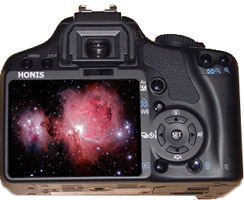 Canon Digital Rebel XSi (450D), XS (1000D),
T1i (500D), T2i (550D),
Canon Digital Rebel XSi (450D), XS (1000D),
T1i (500D), T2i (550D), Canon Digital Rebel XSi (450D), XS (1000D),
T1i (500D), T2i (550D),
Canon Digital Rebel XSi (450D), XS (1000D),
T1i (500D), T2i (550D),Because of the number of requests I get from customers (about 90%) for the Full Spectrum modification and because of the increased detail, I am only doing Full Spectrum modifications. I stopped doing Baader modifications in January 2016.
The Full Spectrum modification using the Astronomik multicoated and optically polished clear glass filter has these advantages:
1. A Full Spectrum modified DSLR is similar in its configuration to commercial CCD color cameras in that no filter is permanently mounted in front of the imaging sensor as is done with the Baader filter modification. Imaging filters of the type available for commercial CCD cameras can be used with a Full Spectrum modified camera as desired. Specialized clip-in type filters that have become available in recent years can also be used.
2. Astro imaging in the Ultraviolet and Infrared wavelengths can be done with a full Spectrum modification since these wavelengths are not blocked as in the Baader filter modified camera.
3. For light transmission, only two optical surfaces are in the camera body in front of the imaging sensor as opposed to four optical surfaces with a Baader modified camera.
4. Provides increased sensitivity for imaging with reflector, Schmidt-Cassegrain and RC telescopes that can focus infrared light and visible light to the same focus point when imaging at prime, and do not require use of an infrared filter.
5. Allows the modified camera to be used for daytime infrared photography using specialized infrared pass filters such as the popular Hoya R72.
6. Simple spectroscopy of bright stars can be done with a Full Spectrum DSLR camera.
7. The Astronomik MC Clear Glass used for the modification is of higher quality than the Baader and Astrodon DSLR replacement filters. It is common for the Baader and Astrodon DSLR replacement filters to have surface imperfections, although the camera's Dust Delete Data function can be used to remove their appearance in normal daytime photos and flat images remove them for astrophotos. But for video imaging of the planets, Moon and Sun, there is no way of removing the artifacts. I have never seen an Astronomik MC Clear Glass with a coating imperfection.
8. I have some tests that show increased detail with a Full Spectrum modification here:
http://garyhonis.com/FullSpectrum/FullSpectrum.html
9. The Astronomik MC Clear Glass is multicoated and tests show it does a little better to reduce halos around bright stars than the original Canon front filter that is removed in a Full Spectrum modification.